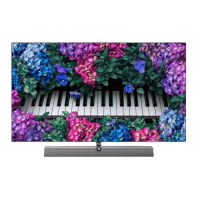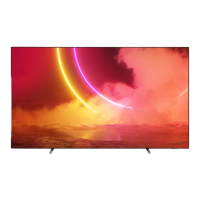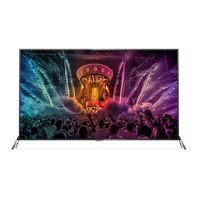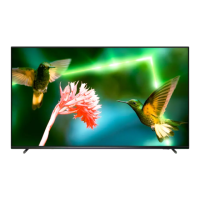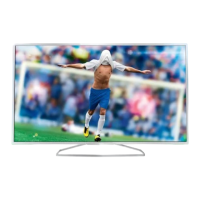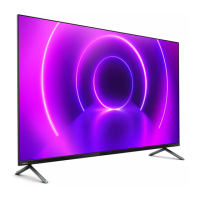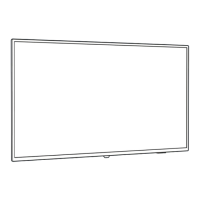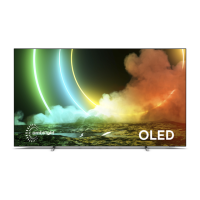
Do you have a question about the Philips 65OLED706 and is the answer not in the manual?
| Noise reduction | - |
|---|---|
| Processor cores | 4 |
| Parental control | Yes |
| Teletext standards | Hyper-text |
| Audio formats supported | AAC, MP3, WAV, WMA, WMA-PRO |
| Image formats supported | BMP, GIF, HEIF, JPEG, PNG |
| Video formats supported | AVC, AVI, H.264, H.265, HEVC, MKV, MPEG1, MPEG2, VP9 |
| Video compression formats | H.264, H.265 |
| Subtitle formats supported | SMI, SRT, SUB, TXT |
| High Dynamic Range (HDR) technology | Dolby Vision, High Dynamic Range 10 (HDR10), High Dynamic Range 10+ (HDR10 Plus), Hybrid Log-Gamma (HLG) |
| Package type | Box |
| Package depth | 170 mm |
| Package width | 1660 mm |
| Package height | 1002 mm |
| Package weight | 35600 g |
| Product color | Silver |
| Housing material | Plastic |
| Panel mounting interface | 300 x 300 mm |
| AC input voltage | 220 - 240 V |
| AC input frequency | 50 - 60 Hz |
| Energy efficiency scale | A to G |
| Power consumption (standby) | 0.3 W |
| Power consumption (typical) | 137 W |
| Wi-Fi standards | 802.11a, 802.11b, 802.11g, Wi-Fi 4 (802.11n), Wi-Fi 5 (802.11ac) |
| Bluetooth version | 5.0 |
| Programming period | 8 day(s) |
| Audio decoders | DTS, Dolby Atmos, Dolby Digital |
| Subwoofer type | Active subwoofer |
| RMS rated power | 50 W |
| Number of speakers | 2 |
| Video apps | Amazon Prime Video, BBC iPlayer, Disney+, Netflix, YouTube |
| Operating system version | 10 |
| Operating system installed | Android |
| RF ports quantity | 1 |
| Common interface (CI) | No |
| USB 2.0 ports quantity | 3 |
| USB 3.2 Gen 1 (3.1 Gen 1) Type-A ports quantity | 0 |
| Tuner type | Analog & digital |
| Analog signal format system | PAL, SECAM |
| Digital signal format system | DVB-C, DVB-S, DVB-S2, DVB-T, DVB-T2, DVB-T2 HD |
| Screen shape | Flat |
| Response time | - ms |
| Display diagonal | 65 \ |
| Display brightness | - cd/m² |
| Display technology | OLED |
| Native aspect ratio | 16:9 |
| Native refresh rate | 120 Hz |
| Supported video modes | 1080p, 1440p, 2160p |
| Display diagonal (metric) | 164 cm |
| Screen format adjustments | 4:3, 16:9 |
| Supported graphics resolutions | 1920 x 1080 (HD 1080), 2560 x 1440, 3840 x 2160 |
| Operating temperature (T-T) | 5 - 35 °C |
| Harmonized System (HS) code | 85287280 |
| Repairability index | 6.3 |
| Stand depth | 280 mm |
|---|---|
| Stand width | 797.5 mm |
| Width (with stand) | 1448.7 mm |
| Height (with stand) | 845.9 mm |
| Weight (with stand) | 28300 g |
| Depth (without stand) | 58 mm |
| Height (without stand) | 829.5 mm |
| Weight (without stand) | 27900 g |
Explains the TV's Home screen, channels, apps, and live TV features.
Emphasizes reading safety instructions before using the TV.
Instructions for installing the TV stand or wall mount.
Overview of the top, middle, and bottom sections of the remote control keys.
Steps to pair the Bluetooth remote control for advanced features.
How to use voice commands to search for content on the TV.
How to switch the TV on, off, or to standby mode.
About channel lists, icons, radio stations, and opening/searching channels.
How to lock channels to prevent viewing and unlock them.
Setting age ratings to prevent children from watching unsuitable programs.
Steps to create and name a new favorite channel list.
Details on automatic and manual channel updates.
Steps to reinstall all channels or reinstall the TV.
Steps to copy the channel list to a USB flash drive.
HDMI quality, cable recommendations, and Ultra HD.
Connecting audio devices via HDMI ARC/eARC.
Operating CEC-compatible devices with the TV remote.
Connecting HTS to TV using HDMI ARC/eARC.
Troubleshooting distorted sound with DTS content.
Troubleshooting no sound issues with HTS.
Steps to pair Bluetooth devices like speakers or gamepads.
Requirements for pausing/recording TV with a USB Hard Drive.
Steps to connect and format a USB Hard Drive.
How to format a USB Hard Drive for pause/record functions.
Connecting a computer to use the TV as a PC monitor.
Connecting the TV to a home network via Wi-Fi or Ethernet.
Requirements for connecting the TV to the internet.
Steps for wireless and wired network connections.
Detailed steps for establishing a Wi-Fi or wired connection.
Troubleshooting common network connection issues.
Steps to sign in with a Google Account for full TV capabilities.
Detailed steps to sign into Google on the TV.
Renting or buying movies and TV shows via Google Play.
Playing games on TV via Google Play Games.
Downloading and installing new apps from the store.
Locking unsuitable apps and setting restricted profiles.
Steps to set up a restricted profile and choose allowed apps.
Stopping apps, clearing cache, and uninstalling unused apps.
Checking internal TV memory usage and free space.
How to start and use the TV's internet browser.
Switching between connected devices like tuners, USB drives, or players.
Information on connecting the TV to a network.
Pairing, selecting, and removing Bluetooth devices.
Adjusting picture settings like style, colour, contrast, sharpness, and brightness.
Selecting preset picture styles for easy adjustment.
Adjusting picture colour, contrast, sharpness, and brightness.
Using noise reduction and MPEG artefact reduction for cleaner images.
Advanced colour settings for tint, enhancement, and gamut.
Selecting optimized motion setting modes for different content.
Adjusting picture to fill the screen completely.
Redoing initial picture settings for brightness, contrast, colour, sharpness.
Selecting preset sound styles for movies, music, games, etc.
Customizing sound settings like speaker virtualizer and clear dialogue.
Connecting compatible speakers for wireless audio streaming.
Personalizing audio based on hearing ability.
Creating a Hearing ID for personalized sound.
Optimizing sound quality by calibrating TV speakers to room acoustics.
Setting audio output format for connected home theatre systems.
How to switch Ambilight on or off.
Setting Ambilight to follow video, audio, lounge light, flag, or app.
Setting Ambilight to match video dynamics.
Using preset colour styles for Ambilight.
Setting Ambilight to match audio dynamics.
Setting up and formatting a USB Hard Drive for recording.
Connecting and operating HDMI CEC compatible devices.
Using the TV remote to control CEC devices.
Displaying Ultra HD signals and setting signal quality.
Configuring HDMI Ultra HD signal quality settings.
Setting up and configuring the Auto Film mode.
Resetting TV settings and reinstalling channels.
Resetting all TV settings to factory defaults.
Performing a full TV reinstallation.
Managing installed apps and storage on the TV.
Enabling features for users with hearing or visual impairments.
Enabling adapted audio and subtitles for hearing impaired.
Enabling audio commentary for visually impaired.
Setting or changing the Child Lock PIN code.
Locking Philips apps and setting up restricted profiles.
Setting a recording for current or future TV programs.
Requirements and process for recording digital TV broadcasts.
Scheduling recordings for upcoming programs.
Recording the current program or scheduling future recordings.
Instantly recording the program currently being watched.
Viewing and managing recorded programs and scheduled recordings.
Pausing and resuming digital TV broadcasts.
Requirements for using the Pause TV feature.
How to pause, resume, and replay broadcasts.
Using the Philips TV Remote App for control and media.
Using Google Cast for app casting from mobile devices.
Requirements for playing games from TV collection, Play Store, or console.
Setting Ambilight to follow video, audio, lounge light, flag, or app.
Setting up sunrise alarms with Ambilight, music, and weather.
Simulating sunset to unwind before sleep, with auto standby.
Setting up Hue bulbs to follow Ambilight colours.
Setting up Philips Wireless Home Speakers to follow Ambilight.
How to open and use the Netflix app on the TV.
Overview of Alexa voice control operations on the TV.
Setting up and using Alexa for TV control.
Updating TV software from the Internet or USB.
Updating software via an internet connection.
Updating software using a USB flash drive.
Solutions for common TV issues like no power or remote problems.
Troubleshooting TV not switching on or responding.
Troubleshooting remote control not working.
General care instructions for OLED displays.
Specific advice for preventing image retention on OLED TVs.
Solutions for missing or distorted picture.
Troubleshooting when sound is present but picture is not.
Addressing issues with poor antenna signal quality.
Troubleshooting picture issues with connected devices.
Troubleshooting sound issues.
Solutions for lack of audio or poor sound quality.
Troubleshooting HDMI and USB related sound issues.
Troubleshooting network connectivity and internet access.
Solutions for Wi-Fi connection problems.
Troubleshooting when internet access fails.
Troubleshooting Bluetooth pairing and connection issues.
Steps to resolve Bluetooth pairing failures.
Information on contacting customer care for support and repairs.
Important safety instructions to prevent injury and damage.
Precautions to prevent electric shock and fire hazards.
Safety measures to prevent physical injury or TV damage.
Precautions before connecting the TV to power.
Preventing TV from falling and causing injury.
Safety precautions related to batteries.
Ensuring proper ventilation to prevent overheating.
Safety measures during lightning storms.
Avoiding hearing damage from high volume use.
Guidelines for cleaning and maintaining the TV screen.
Reducing screen burn-in risk from static images.
Troubleshooting common picture display issues.
Legal terms and conditions for using the TV.
